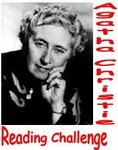 In The Thirteen Problems by Agatha Christie a group of friends, including Miss Marple meet on a Tuesday night and tell sinister stories of unsolved mysteries. It was first published in the UK in 1933, collecting together short stories previously published in various magazines. The first story The Tuesday Night Club introduces the character of Miss Marple.
In The Thirteen Problems by Agatha Christie a group of friends, including Miss Marple meet on a Tuesday night and tell sinister stories of unsolved mysteries. It was first published in the UK in 1933, collecting together short stories previously published in various magazines. The first story The Tuesday Night Club introduces the character of Miss Marple.
The members of the Tuesday Night Club are Miss Marple, her nephew Raymond West a writer, Joyce Lempriere an artist, Sir Henry Clithering the ex-Commissioner of Scotland Yard, Dr Pender a clergyman and Mr Petherick a solicitor. Raymond wonders what type of person succeeds best at unravelling mysteries and puts forward that the ‘art of writing gives one an insight into human nature’, but Miss Marple questions him thinking that ‘so many people seem to me not to be either bad or good, but simply, you know, very silly.’ Mr Petherick thinks imagination is dangerous and that it needs a legal mind to sift through the evidence looking only at facts to arrive at the truth. Whereas Joyce believes it takes a woman’s intuition, such as hers – an artist who has ‘knocked about among all sorts and conditions of people’. She discounts Miss Marple thinking she cannot possibly know about life only having lived in St Mary Mead.
So they each tell a tale and are amazed when it is Miss Marple, sitting primly, ‘knitting something white and soft’ who comes up with the right solution each time by using her knowledge of human nature gleaned from observing similar cases in St Mary Mead. She sees similarities and makes connections the others overlook.
The second set of stories are told at Colonel and Mrs Bantry’s house, when the guests tell their after-dinner stories. Sir Henry is visiting them and suggests they invite Miss Marple to make a sixth guest at dinner, along with Jane Helier the beautiful and popular actress, and the elderly Dr Lloyd. Again Miss Marple correctly solves the mysteries, seeing through the red herrings to discover even the crimes that no one even knew had been committed. As she says
a lot of people are stupid. And stupid people get found out, whatever they do. But there are quite a number of people who aren’t stupid, and one shudders to think of what they might accomplish unless they had very strongly rooted principles.
The Thirteen Problems is an easy read and the short stories are ideal for reading quickly and in isolation. They are not complicated and once Miss Marple starts her explanations the crimes are easily solved.
I particularly liked the first description of Miss Marple, sitting erect in a big grandfather chair she
wore a black brocade dress, very much pinched in round the waist. Mechlin lace was arranged in a cascade down the front of her bodice. She had on black lace mittens, and a black lace cap surmounted the piled up masses of her snowy hair.
Kerrie recently ran a poll asking Who is the Best Miss Marple? My answer was Joan Hickson because I liked her portrayal, and the way she spoke and behaved seemed to me to be Miss Marple. But even though she looked nothing like this description I still prefer to ‘see’ Joan Hickson as Miss Marple. A strange case (for me) of a TV portrayal taking precedence over a book.
I’m in full agreement about Joan Hickson. The Thirteen Problems is a nice book of stories, and the Marple character a brilliant concept.
LikeLike
Excellent review of this fun book. I just love Miss Marple and have read her stories many times just so .I can “visit” with her again. I liked your quote of how Miss Marple looked. I also like Joan Hickson although I cast my vote for Helen Hayes. I just wanted her to be recognized and I guess I liked her portrayal of Miss Marple because she is an American like me. Of course only a proper English actress should do Miss Marple.
LikeLike